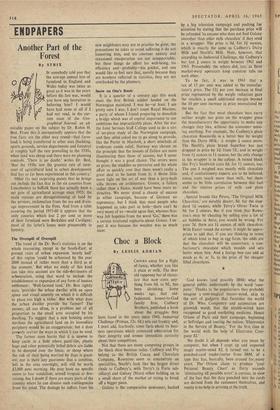Choc a Block
By LESLIE ADRIAN
Not that there are many competing groups in the block choc business today. Cadbury and Fry belong to the British Cocoa and Chocolate Company, Rowntree seem to concentrate on specialities,. Nestles look like the, largest direct rivals to Cadbury's, with Terry's (a Forte sub- sidiary) and Galaxy (Mars) either holding on to a small share of the market or trying to break off a bigger piece.
Galaxy is the comparative newcomer, backed
by a big television campaign and pushing for attention by stating that the purchase price will be refunded `to anyone who does not find Galaxy smoother than other milk chocolate' if they send in a wrapper. The price is 6d. for 14 ounces, which is exactly the same as Cadbury's Dairy Milk and Nestld's Milk. Note, however, that according to Industrial Challenge, the Cadbury's bar lost ounce in weight between 1962 and 1963. Presumably the others did, too, as these market-wary operators keep constant tabs on each other.
To be fair, it was in 1963 that a tax of 15 per cent was added to the manufac- turer's price. The 124 per cent increase in final price represented by the weight reduction gave the retailers a small additional margin beyond the 10 per cent increase in price necessitated by the tax.
But the fact that most chocolate bars carry neither weight nor price on the wrapper gives the manufacturers the opportunity to make any changes they like, without the consumer notic- ing anything. For example, the Cadbury's plain chocolate Bouroville h a better buy by weight than the Dairy Milk : it weighs 4 ounce more. The Nestld's plain brand Superfine has just dropped in price by Id. from 7d., and in weight from 14 ounces to If ounces, but the only change in the wrapper is in the colour. A mixed block like Fry's Sandwich costs 6d. for If ounces, too. The one I weighed was mostly milk chocolate and, if confectionery experts are to be believed, cocoa costs much more than milk, but there seems to be little correlation between this fact and the relative prices of milk and plain chocolate.
Special brands like Peters, 'The Original Milk Chocolate,' are notably dearer, 8d. for the stan- dard If ounces, while Terry's Oliver Twist is 9d. for 2 ounces. But if you think that Rown- tree's may be cheating by selling you a lot of air bubbles in Aero, you would be wrong. For your 7d. there are 14 ounces of milk chocolate. With Easter round the corner, it might be appro- priate to add that, if you are thinking in terms of which kind to buy in egg form, the odds are that the chocolate will be couverture, a con- fectioner's chocolate which moulds and sets better when thin. And a festive box can add as much as 4s. or 5s. to the price of the cheaper filled chocolates.
God knows (and possibly IBM) what the general public understands by the word 'com- puter.' Thanks to the popularisers they probably imagine a semi-magical master-mind, akin to the sort of gadgetry that furnishes the world of Dr. Who. Computery and automation are gimmick words that the nimble-witted have recognised as good marketing medicine. Hence Orlane of Paris and their campaign, beginning at Selfridges and touring the nation, 'Electronics in the Service of Beauty,' For the first time in the world with the help of Electronic Com- puter 82.'
No doubt it all depends what you mean by computer, but when I crept up and inspected magic master-mind 82, it turned out to be a punched-card reader/sorter from IBM, of a type that has, basically, been around for many years. The Orlane claim to produce 'your Personal Beauty Chart' in thirty seconds 'eliminating all possible error' is curious, in view of the fact that the data punched into the cards are derived from the customers themselves, and vanity is no help in arriving at the truth.






























 Previous page
Previous page